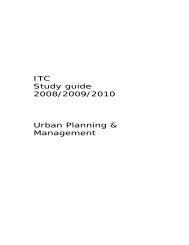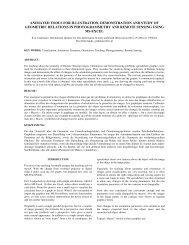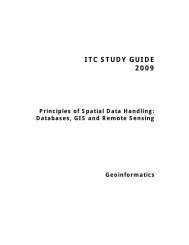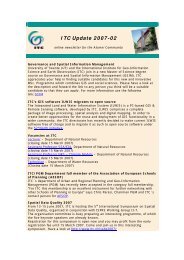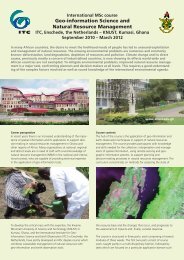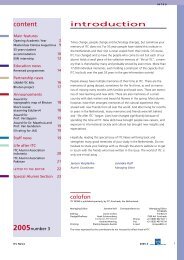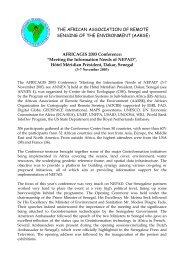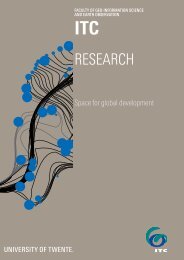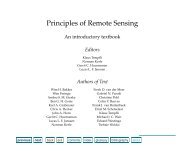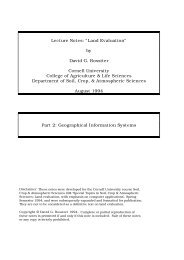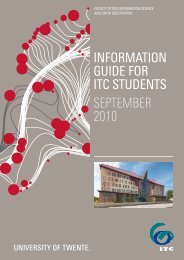Sensitivity Analysis of Soil Site Response Modelling in Seismic ... - ITC
Sensitivity Analysis of Soil Site Response Modelling in Seismic ... - ITC
Sensitivity Analysis of Soil Site Response Modelling in Seismic ... - ITC
You also want an ePaper? Increase the reach of your titles
YUMPU automatically turns print PDFs into web optimized ePapers that Google loves.
3. Shake2000<br />
3.1. Introduction<br />
Local site effects <strong>in</strong>fluence the <strong>in</strong>tensity <strong>of</strong> shak<strong>in</strong>g, and they have been a popular research area for<br />
many earthquake eng<strong>in</strong>eers, seismologists and other scientists. The reason is also it plays an important<br />
role <strong>in</strong> earthquake resistant design <strong>of</strong> build<strong>in</strong>gs. The basics <strong>of</strong> this analysis depend on the wave propagation<br />
theory. In a nutshell the theory comes from seismology, which studies the ability <strong>of</strong> seismic<br />
waves -vibrations <strong>of</strong> Rocks- to propagate through the Earth. Generally, seismic waves do not travel <strong>in</strong><br />
straight l<strong>in</strong>es but are deflected, by refraction or reflection, by the layers they encounter, before they<br />
return to the surface <strong>of</strong> the Earth and this allows the <strong>in</strong>ternal structure to be determ<strong>in</strong>ed (Musset and<br />
Khan 2000).<br />
Us<strong>in</strong>g wave propagation theory comb<strong>in</strong>ed with material properties and seismic <strong>in</strong>put motion the expected<br />
ground movement could be determ<strong>in</strong>ed. This is done us<strong>in</strong>g quantitative <strong>in</strong>puts <strong>in</strong>to complex<br />
mathematical calculations. One <strong>of</strong> the earliest and most successful attempts was <strong>in</strong> the early seventies<br />
when Schabel and Lysmer (1972) published, “A computer program for conduct<strong>in</strong>g equivalent l<strong>in</strong>ear<br />
seismic response analyses for horizontally layered soil deposits” called SHAKE. This s<strong>of</strong>tware was<br />
based on Kanai (1951), Roesset and Whitman (1969), and Tsai and Housner (1970), SHAKE assumes<br />
that the recurrent and circular soil behaviour can be simulated us<strong>in</strong>g an equivalent l<strong>in</strong>ear model (e.g.<br />
(Kramer 1996)). From then, many upgrades and derived programs have been released. In general the<br />
upgrades were focused on the user friendl<strong>in</strong>ess <strong>of</strong> the s<strong>of</strong>tware; the fundamental part; the core algorithm<br />
was left untouched. The program is still <strong>in</strong> use widely all over the world and the upgrades are<br />
still cont<strong>in</strong>u<strong>in</strong>g <strong>in</strong> the same way.<br />
3.2. Background<br />
The s<strong>of</strong>tware that is used <strong>in</strong> this research is called SHAKE2000, which is a s<strong>of</strong>tware package that <strong>in</strong>tegrates<br />
ShakEdit and SHAKE. Computer programs such as WESHAKE (Wallace, 1999), ProShake<br />
(Edu Pro Civil Systems, 2002) and ShakEdit are examples <strong>of</strong> the trend towards the development <strong>of</strong><br />
the next generation <strong>of</strong> user-friendly, geotechnical earthquake eng<strong>in</strong>eer<strong>in</strong>g s<strong>of</strong>tware. ProShake, was<br />
developed from EduShake, is a public doma<strong>in</strong> program developed to help eng<strong>in</strong>eer<strong>in</strong>g students understand<br />
the mechanics <strong>of</strong> seismic ground response. Differ<strong>in</strong>g from the ProShake, EduShake can only be<br />
used with the seven ground motions that are <strong>in</strong>cluded <strong>in</strong> the s<strong>of</strong>tware itself. The development <strong>of</strong><br />
EduShake evolved through several stages and was eventually beta tested by graduate students, researchers<br />
and practic<strong>in</strong>g eng<strong>in</strong>eers. After a few modifications <strong>in</strong> response to the comments <strong>of</strong> beta testers,<br />
EduShake was made public doma<strong>in</strong>. Shortly thereafter, the restrictions <strong>of</strong> EduShake were removed<br />
and a few additional features added to produce ProShake. And, ProShake featured a w<strong>in</strong>dows<br />
graphical user <strong>in</strong>terface that both simplifies and speeds the analysis and <strong>in</strong>terpretation <strong>of</strong> seismic<br />
ground response (Edu Pro Civil Systems, 2002 ).<br />
38<br />
<strong>Sensitivity</strong> <strong>Analysis</strong> Of <strong>Soil</strong> <strong>Site</strong> <strong>Response</strong> <strong>Modell<strong>in</strong>g</strong> In <strong>Seismic</strong> Microzonation For Lalitpur, Nepal



